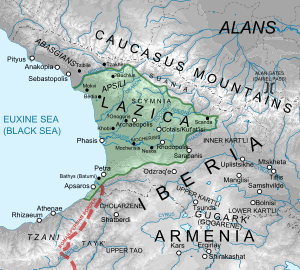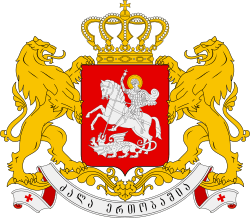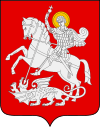Lazica
Lazica (Georgian: ეგრისი, Egrisi; Laz: ლაზიკა, Laziǩa; Greek: Λαζική, Lazikí; Persian: لازستان, Lâzestân; Armenian: Եգեր, Yeger) was the Latin name given to the territory of Colchis during the Roman/Byzantine period, from about the 1st century BC.
Kingdom of Lazica ეგრისის სამეფო | |||||||||
|---|---|---|---|---|---|---|---|---|---|
| 131 AD–697 AD | |||||||||
 The kingdom of Lazica in Late Antiquity | |||||||||
| Status | Kingdom | ||||||||
| Capital | Archaeopolis | ||||||||
| Common languages | Zan language, and other South Caucasian languages | ||||||||
| Religion | Eastern Orthodox Church | ||||||||
| King | |||||||||
• 131 AD | Malassas (first) | ||||||||
• 696/697 | Sergius (last) | ||||||||
| Historical era | Classical antiquity | ||||||||
• Established | 131 AD | ||||||||
• vassal of Roman Empire | 3rd to 5th century | ||||||||
| 541 to 562 AD | |||||||||
• annexation of Lazica by Byzantine Empire | 7th | ||||||||
• Disestablished | 697 AD | ||||||||
| |||||||||
| Today part of | Countries today
| ||||||||
History
By the mid-3rd century, Lazica was given partial autonomy within the Roman Empire and developed into kingdom. Throughout much of its existence, it was mainly a Byzantine strategic vassal kingdom that briefly came under Sasanian Persian rule during the Lazic War. The kingdom fell to the Muslim conquest in the 7th century. Lazica in the 8th century successfully repelled the Arab occupation and formed part of the Kingdom of Abkhazia from c. 780, one of the early medieval polities which would converge into the unified kingdom of Georgia in the 11th century.
Ecclesiastical history
In the early 4th century, the Christian eparchy (eastern bishopric) of Pityus was established in this kingdom, and as in neighboring Iberia Christianity was declared as an official religion in AD 319.[1][2] Other ancient episcopal sees in Lazica include Rhodopolis,[3] Saesina,[4] and Zygana.[5] In 325 among the participants of the First Council of Nicaea was the bishop of Pityus, Stratophilus. The first Christian king of Lazica was Gubazes I; in the 5th century, Christianity was made the official religion of Lazica. Later, the nobility and clergy of Lazica switched from the Hellenic ecclesiastic tradition to the Georgian, and Georgian became the language of culture and education. The Bichvinta Cathedral is one of oldest monuments of the Georgian Christian architecture constructed by the King Bagrat III Georgia (978-1014, an Orthodox saint).[6]
Rulers
| Ruler | Reign | Notes |
|---|---|---|
| 1. Malassas | mentioned by Arrian in 131 | vassal of the Roman Emperor Hadrian. |
| 2. Pacorus | a contemporary of the Antoninus Pius (r. 138–161) | his name is found on a coin issued by him. |
| 3. Gubazes I | attested c. 456 – 466 | |
| 4. Damnazes | ?–521/522 | |
| 5. Tzath I | attested 521/522 – 527/528 | |
| 6. Opsites | dates of reign unknown, likely some time before 541 | |
| 7. Gubazes II | c. 541 – 555 | |
| 8. Tzath II | 556–? | |
| 9. Lebarnicius | c. 662 | mentioned as "patricius of Lazica" in the
Hypomnensticum of Theodosius and Theodore of Gangra |
| 10. Grigor | 670 – c. 675 | |
| 11. Sergius | c. 696/697 |
| History of Georgia |
|---|
 |
|
Middle Ages
|
|
Early modern history |
|
Modern history |
|
History by topic |
|
|
| Laz people |
|---|
 |
|
|
|
See also
References
- The Church Triumphant: A History of Christianity Up to 1300, E. Glenn Hinson, p 223
- Georgian Reader, George Hewitt, p. xii
- Annuario Pontificio 2013 (Libreria Editrice Vaticana, 2013, ISBN 978-88-209-9070-1), p. 959
- Annuario Pontificio 2013, p. 979
- Annuario Pontificio 2013, p. 1013
- W.E.D. Allen, A history of the Georgian people (1932), p. 276.
| Wikimedia Commons has media related to Lazika. |

